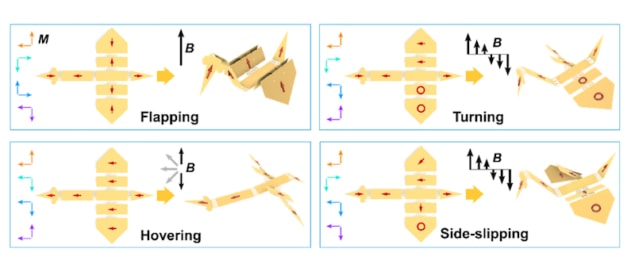
Micron-sized soft robots that can be made to quickly morph into different shapes using an applied magnetic field have been created by researchers in Switzerland. Their work could help in the development of intelligent micromachines that can be reprogrammed in situ to adapt to complex environments.
Microbots made of soft or flexible materials could find a wide range of uses, including in biomedical devices that can be introduced into the body to do tasks such as biopsies, surgery and drug delivery. Until now, most of these robots had fixed shapes and cannot easily change their forms once in place.
Now, researchers led by Laura Heyderman and Bradley Nelson at ETH Zurich and the Paul Scherrer Institute have developed a technique to make a microrobot that incorporates arrays of single-domain nanomagnets on connected, folding panels. The shape of the microbot can be programmed by applying a specific sequence of magnetic fields of varying strengths to the nanomagnets to encode their magnetic configurations.
Origami inspirations
The transformations are based on origami, which is the Japanese art of paper folding. The folding is actuated in a predefined way using a controlling magnetic field, explain team members Jizhai Cui and Tian-Yun Huang. The nanomagnets are made from cobalt and are 100-500 nm long and 60-110 nm wide. Individual nanomagnets are magnetized in the long direction. By arranging the nanomagnets on a panel, the magnetization of a panel can be pre-set (or encoded) in one of two possible perpendicular directions in the plane of the panel (signified as “0” and “1”).

The researchers designed their micromachines with two types of elements: rigid magnetic panels and soft springs that act as hinges connecting the panels. They made their devices using a technique called electron-beam lithography, which allows them to prepare arrays of nanoscale magnets on the panels, which are made of a thin layer of silicon nitride.
Four-panel micromachine
To demonstrate their encoding concept, the team began by building a simple four-panel micromachine, with each panel patterned with 60 nm thick nanomagnets. They then built an assembly of these panels and showed that they could programme them to morph into the shapes of the different letters of the alphabet. They also made a microscale “transformer bird” carrying the nanoscale magnets that can flap, hover, turn and side-slip.

Origami brings soft logic to robotics
This concept of nanomagnetic encoding could be useful for many scientific and engineering applications, including biomedical robots, smart sensors, actuators, active metamaterials and flexible electronics, say Cui and Huang .
Reporting its work in Nature, the team says that it is now trying to build magnetic coils to apply pulsed magnetic fields to the devices. This will allow them to be reprogrammed in situ after they have been released for operation, Cui and Huang tell Physics World.
Much work still needs to be done to unleash the full potential of magnetic soft robots, but the advanced fabrication platforms used by the team will be crucial for implementing future designs of these devices – according to Xuanhe Zhao and Yoonho Kim of the Massachusetts Institute of Technology, who comment on the research in a Nature “News & Views” article.



